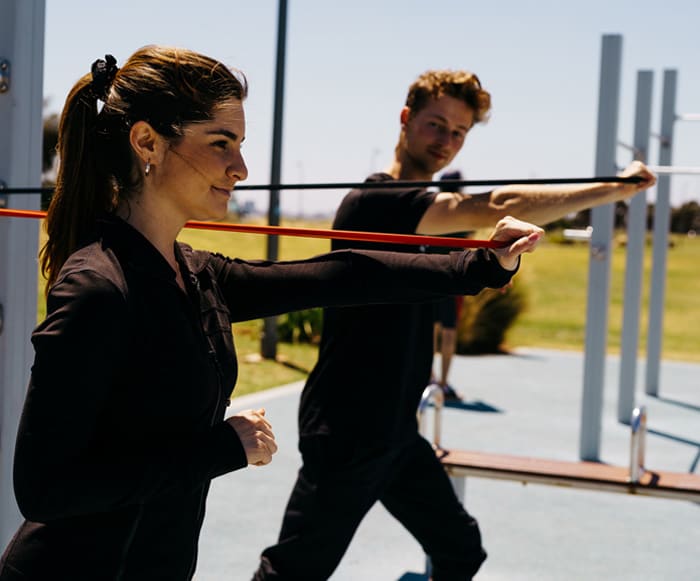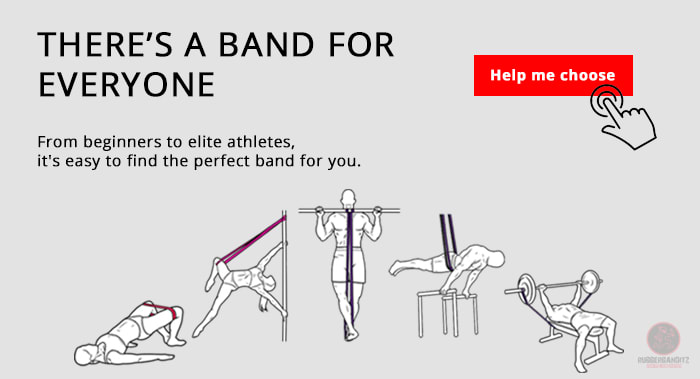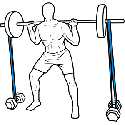Calisthenics is a bodyweight art that takes inspiration from gymnastics and infuses it with its own artistic flavor. It's a largely bodyweight discipline that encompasses traditional bodyweight exercises, static holds, and calisthenics freestyle.
Often, gymnasts are initiated into the sport when they are children, and as such, their bodies are able to adapt to the workload very quickly. In calisthenics, on the other hand, athletes usually start much later in life. Starting such an intense sport in your 30s and 40s can be a difficult task, but it’s not impossible. In fact, there are many tools that can be used to make this journey smoother than it would otherwise be.
Resistance bands are just one such tool. In this article, we will explore how to use resistance bands in calisthenics.
Resistance bands - making calisthenics achievable for adults
Resistance bands are a latex band that has many uses in calisthenics. Resistance bands are great for warm ups, stretching, assisting bodyweight exercises and for doing resistance exercises that target muscles that are otherwise difficult to target with bodyweight workouts.
There are many different types of resistance bands on the market, from glute bands to bands with various handles and attachments. The resistance bands used in calisthenics are often called pull up bands, as this is their most popular use. These are longer bands that are made in a continuous loop, and that do not have any handles or attachments.
One of the main advantages of resistance bands is that they come in sets. Each set contains bands of differing thicknesses. The different thicknesses translate into the bands’ ability to create force, and therefore assist with bodyweight exercises or provide resistance for resistance exercises. This is fantastic as it allows progressive overload, similar to what can be achieved with weights at the gym.
Warming Up with Resistance Bands
Resistance bands are a great tool for warming up. They can be used for a variety of dynamic stretching exercises, especially for the shoulders. Shoulders are one of the primary joints used in calisthenics and are also one of the most prone to injury due to their relatively large dynamic range. The shoulder joint is stabilised by rotator cuff muscles, which can be easily torn when cold.
To effectively warm up the shoulders you need to complete the dynamic stretches at the limit of the shoulders’ range of motion. This is done so that future motions with greater force are less likely to damage the muscle fibers of the rotator cuffs.
Furthermore, the shoulder should be moved through all of its basic movement patterns while under tension from a resistance band. This will ensure that the shoulder is primed for any external force. These motions include internal rotation, external rotation, flexion and extension.
The arms can also be warmed up by completing basic pulls and pushes using resistance bands. Band pushes are a great chest and tricep warm up to be done before push ups, and pulls are a great back and bicep warm up to be done before pull ups and rows.
Resistance exercises with resistance bands
Resistance bands can also be used for a variety of resistance exercises. Typically bands need to be tethered to an anchor. They can then be used for much the same exercises as a standard cable machine. You can use one band at a time or two at a time and push or pull them from any angle.
Press with Resistance Bands

Pulls with Resistance Bands
Here are some examples of resistance exercises that can be performed with resistance bands:
- Front raise - this is a great exercise for the anterior deltoid. Attach the band quite low to the ground. Hold the band, and while keeping your arm straight, press the band to chest height.
- External rotations - a great exercise for the back, posterior deltoid and for correcting posture. Attach the band to an anchor at chest height. Stand at 90 degrees to the band’s anchor point, and with the hand furthest away, rotate outward at chest height with a straight arm.
- Chest Press - a great exercise for the chest and triceps. The chest press won’t substitute for push ups, but it can be a great exercise for beginners to increase strength before attempting push ups. Attach the band to an anchor at chest height and stand facing away from the band. Bring one foot forward and move into a shallow lunge before press straight in front with the hand holding the band.
Smashing out Isometrics using Resistance Bands
Resistance bands are paramount to mastering static holds in calisthenics. They provide an easy transition into exercises that require what seems like superhuman strength. Resistance bands are able to reduce effective body weight, which allows for statics like front lever and planche to become dramatically easier.
If you have access to a fitness station, then you should be able to tether the band to a bar above you. Generally, the resistance band supports from above either at the hips or at the feet. When the band supports at the feet the exercise becomes easier as the force is applied with a greater lever arm (basic physics).
Sometimes, like in front lever, you need to be creative in the way you tether the band. When you tie the band to the bar that you hang from and attempt the front lever, you create an undesirable directional force that pulls your body into the bar rather than up through the feet or hips. To avoid this you can try to tie the band to a monkey bar set and have the band pass over several steps before placing your feet on it. This will create a vertical force without any other undesirable directional force.
Once you have correctly tethered the band, grab onto one of the rungs of the monkey bars several rungs away from the band. Engage your back and core and attempt to lift your body and hold it parallel to the ground. It should feel like you’re pulling your hips to the bar while maintaining straight arms.
Planche is another isometric hold that can be made significantly easier using a resistance band. Simply tie the band around a bar and thread yourself through it such that the band rests on your hips. Assume the push up position and lean forward and attempt to take your feet off the ground. Make sure your arms remain locked. The band should provide an upward lift that will make the exercise much easier.
Assisting Bodyweight Exercises with Resistance Bands
Probably the most common use for resistance bands as pertains to calisthenics training is assisting with bodyweight exercises. Many beginners struggle with calisthenics because the entry barrier is so high. Although many athletes see these exercises as staple exercises that require little to no effort, for many, push ups, pull ups and dips are not easy exercises.
Due to the elastic nature of resistance bands, they can create an opposing force to gravity. Resistance bands can make these exercises easier by reducing effective body weight. This is great if bodyweight exercises are too hard and you’re not hitting the recommended 8-12 range for muscle hypertrophy.
Resistance band sets allow you to hit the optimal range for bodyweight exercises and to progressive through the principle of progressive overload - which can be easily achieved by moving to a thinner band. They can also let you do compound exercises that you otherwise would not have the strength for. This is great for moving beginners through difficult exercise variations that work different muscle groups.
For example, diamond push ups are a great push up variation that targets the triceps. It’s too difficult for most beginners and so they wouldn’t get the awesome benefits from this exercise. However, when assisted with a resistance band, beginners can complete this exercise without any problems, receiving its full benefits.
Most commonly, however, resistance bands are used to assist in pull ups
Pull ups are a particularly difficult exercise because they require calisthenics practitioners to lift their entire body weight, not something we do in everyday life. This is particularly difficult for anyone that has not maintained a regular exercise routine - as this strength is easily lost. Exercise bands for assisted pullups allow beginners to train pull ups with assistance, and help overload the exercise in a sustainable way.
First, tie the resistance band to a bar above you. Thread your feet through the band and keep your feet slightly in front of the bar. Pull yourself so that your chin peaks over the bar. Make sure the scapula retracts and depresses throughout this motion. This will prevent the engagement of undesirable muscle groups such as those in the neck.
Resistance Bands for Muscle Ups
Resistance bands can also help you achieve the infamous muscle up! Muscle ups are a difficult skill that requires a lot of power. Often calisthenics practitioners falter because they are not able to pull themselves high enough on the bar. Athletes also tend to stay too close to the bar, which results in them not being able to clear the bar. Resistance bands solve both of these problems.
The resistance band helps athletes clear the bar by reducing effective body weight. It also keeps the feet forward which makes your entire body lean slightly back. This creates space between your body and the bar, which allows you to transition on top of the bar. Once you’ve cleared the bar, remember to lean forward again though, as otherwise you’ll be too far away!
Stretching with resistance bands
Resistance bands are also great to stretch with. Some of the best stretches that can be done with resistance bands are for the chest and shoulders. By tethering the band to an anchor point, you can create a flexible handle to pull your arm back. Depending on the angle, you can target the chest or the shoulders. 45 degrees between horizontal and vertical is most effective for the chest, while straight up vertically is most effective for the shoulder.
To make the stretches even more effective they can be done with a partner. Lie down prone and stretch out 1 arm. Grab one end of a resistance band and have your partner grab the other while standing. They will then move slowly through a wide circular arc while pulling up on the band. This will stretch the shoulder through its full range of motion and identify any muscle knots.
Resistance bands can also be used to stretch the legs. This can be done in 2 ways. The first requires you to sit in a straddle on the ground. Attach the band to an object in front of you and sit far enough away such that when you grab the band it retains tension. Relax and allow the band to pull you forward. If you need a stronger pull try sitting further away from the band.
Alternatively, if you are more flexible, you can sit in the straddle and hook the band around your feet such that the band loops behind your back from foot to foot. This will force your legs wider and give you a nice glute, hamstring and groin stretch.
Summary:
Calisthenics is a difficult sport - many of the exercises are not achievable for beginners, especially those without a background in bodyweight fitness. Even bodybuilders and weightlifters, despite their strength, often do not have the functional strength to achieve calisthenics feats.
Resistance bands solve this problem rather handily. They are a light-weight piece of equipment that can be used for a variety of different purposes. Resistance bands can double as cables and weights, helping calisthenics athletes build foundational strength and serving as accessory exercises. They can also be used to great effect for warm ups and cooldowns, muscle activation and stretches simply aren’t as effective without them.
Most importantly, however, resistance bands can assist with bodyweight exercises and static holds. They do this by reducing your effective body weight and supporting you posturally in crucial areas, a great way to work around a weak core. Using resistance bands in this way can prevent injury from over-exertion and can dramatically increase the speed of progression - as it allows you to do difficult exercises in rep ranges optimal for applying the principle of progressive overload.
For another great resource, you can check out how to use resistance bands in calisthenics. They collaborated to author this article and have a lot of valuable resources.
Lastly, if you're a personal trainer looking for more resources, we highly recommend that you have a read through the ISSA personal training review by Tyler Read so you know what you need to do!



